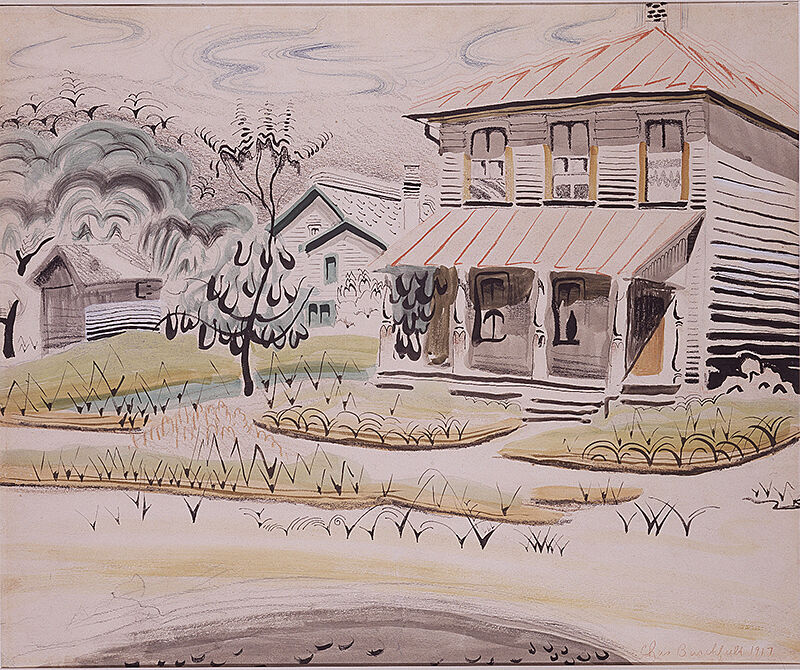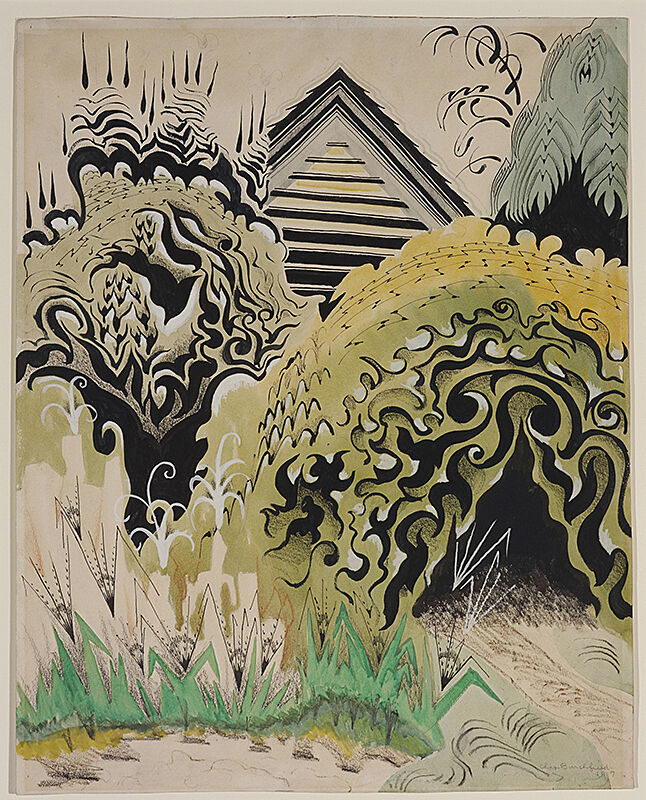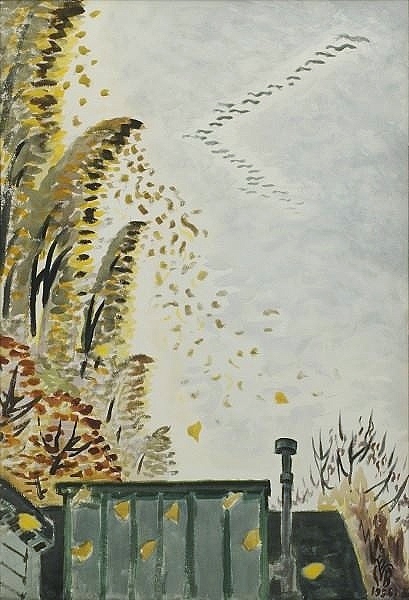Charles Ephraim Burchfield (1893-1967) brought American art to a new level. His work did not fit into any existing category but was a style of modern art not seen before. He was born in Ashtabula, Ohio, but after his father died in 1898, his mother and he moved to Salem, Ohio. While a junior in high school, he was determined to make a record of all the flowering plants in the area. Constantly sketching and painting, he kept a journal of his thoughts and ideas. He said he was “gathering the material for a lifetime.” He was valedictorian at his high school class graduation in 1911. His interest in art was well established by that time. After graduating from the Cleveland Institute of Art in1916, he was awarded a scholarship to attend the National Academy of Design in New York City. He left the Academy one day after attending a life drawing class, and he returned to Ohio.
Burchfield drew upon recollections of life in eastern Ohio: “There gradually evolved the idea of recreating impressions of that period, the appearance of houses, the feelings of woods and fields, memories of seasonal impressions….” “Song of the Katydid on an August Morning” (1917) (18’’x22’’) (watercolor, gouache, colored chalk, pastels) is one of the 400 watercolors and drawings Burchfield would complete over the next few years. He later called this period his “Golden Years.” An accomplished artist, Burchfield was equally at ease with traditional landscape, still-life, and portrait subjects, but landscape was his principal choice. His sensitivity to the sounds of nature, the poetry he heard and felt, the colors that sprung to life in his mind, and the emotions he felt, shaped his uniquely personal style.
Writing in his journals and on the backs of his paintings, he offers the viewer insight into his work. “Song of the Katydid on an August Morning” depicts, in his words, “a stagnant August morning during the drought season, as the pitiless sun mounts into the mid-morning sky, and the insect chorus commences, the katydids and locusts predominating. Their monotonous, mechanical, brassy rhythms soon pervade the whole air, combining with the heat waves of the sun, and saturating trees and houses, and sky.”
“Cricket Chorus in the Arbor” (1917) (22’’x17.5’’) (watercolor, brush and ink, wax crayon) is typical of Burchfield’s work. He was primarily a watercolorist, but he added other media for effect. He described his choice of watercolor in his journals: “I like to be able to advance and retreat just like a man writing a book. I doubt that very few of them ever sit down and leave a paragraph as it first comes into their head. They work over it, delete things and add things. Well, I feel that I like to do that just as they do. Or as a composer does. I mean you start a picture and I don’t know how it is going to turn out. I think I know what I want to do but, when I put it down it’s not right and it’s got to be changed. I have to find out where the idea wants to go.”
Burchfield knew and recognized the sounds of various insects and developed a type of artistic shorthand to define those sounds: “I noticed the brilliant yellow sunlight at noon–following a clear morning–a solitary katydid, at times, while at noon the cicadas charm me. Crickets are notorious for chirping nonstop in the evenings.”
Burchfield painted the same subject over and over, each time changing the image to create another interpretation of that same subject. He described “The Insect Chorus” (1917) (20’’x16’’) (opaque and transparent watercolor, graphite, and crayon): “It is late Sunday afternoon in August. A child stands alone in the garden listening to the metallic sounds of insects. They are all his world, so, to his mind, all things become saturated with their presence–crickets lurk in the depths of the grass, the shadows of the trees conceal fantastic creatures, and the boy looks with fear at the black interior of the arbor, not knowing what terrible thing might be there.” Burchfield said ‘‘terrible things that might be there’’ perhaps because of the recent discovery that mosquitoes transmitted yellow fever and malaria.
The trees and ferns are drooping as a result of the sweltering heat; their colors are dull green and beige, and their black trunks and branches are distorted. The rounded arbor is a sickly yellow-green, and the entrance to the arbor is a black hole. The V-shapes are the jumping crickets. Burchfield wrote that the crickets’ chirping is a ”high shrill pin-point cricket chorus.”
Burchfield served in the US Army’s camouflage unit, using his painting skills to hide tanks and artificial hills. He was honorably discharged in 1919. He designed wall paper at M.H. Birge & Sons from 1921 until 1928. He married in 1922, had five children, and lived in West Seneca, New York until his death in 1967. Life Magazine named him one of America’s 10 greatest painters in 1926. Beginning in 1929, he was represented by the Frank Rehn Gallery in New York City. Commissions, sales, and teaching positions in several universities supported his family from 1928 onward. Election in 1954 to the National Academy of Design in New York was among the many acknowledgements he received during his career.
He wrote about “Wild Geese and Poplars” (1956) (39’’x26.5’’) (watercolor) in his journal on October 18,1956: “About mid-morning a flight of wild-geese going straight south–As they passed by the poplar trees an extra hard puff of wind scattered leaves over the sky–The sight and sound of wild geese affects me in a way that is hard to understand–My heart begins to pound, and breathing is difficult–It is an elemental event.” Popular trees lined one side of his garden. He worked on the sky for most of the day, but he recognized that the “wild geese cannot be put in without disturbing the sky–which is more important?” He made at least two versions of the subject. The subject would seem to be a simple one, but with only a few strokes of his brush, Burchfield captured the essence of this moment in time.
The Charles E. Burchfield Center at Buffalo State College was opened in his honor in1966. His paintings can be found in over 109 museums in the United States and Europe. Burchfield’s watercolors are his distinctive response to nature through all seasons of the year: “Often I say to myself, ‘This is the best time of the year.’ I say it every day the year thru. And it is true. Every season is the best. I cannot conceive of a true lover of nature despising winter but liking summer or vice versa.”
Beverly Hall Smith was a professor of art history for 40 years. Since retiring with her husband Kurt to Chestertown in 2014, she has taught art history classes at WC-ALL. She is also an artist whose work is sometimes in exhibitions at Chestertown RiverArts and she paints sets for the Garfield Center for the Arts.







Holly Geddes says
I really love this artist. Thanks, Bev.